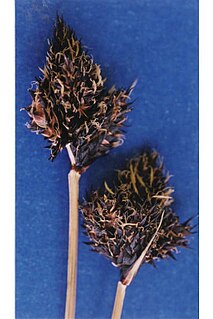
Carex albonigra is a species of sedge known by the common name black and white sedge. It is native to western North America from Alaska and most of western Canada to California to New Mexico, where it grows in mainly dry, rocky high mountain habitat such as talus. This sedge forms a dense clump 10 to 30 centimeters in height with narrow gray-green leaves. The inflorescence is a headlike cluster of overlapping spikes. The fruit is coated in a sac called a perigynium which is dark purple to chestnut brown and often tipped with white.

Carex athrostachya is a species of sedge known by the common name slenderbeak sedge. It is native to western North America, including Alaska to central Canada, the western contiguous United States, and just into Baja California.
Carex fracta is a species of sedge known by the common name fragile sheath sedge. It is native to the western United States from Washington to California, where it grows in moist to dry areas in mountain forests and meadows. This sedge produces dense clumps of stems sometimes exceeding a meter tall. The leaves are attached to the stem with a characteristic thin, membranous sheath. The inflorescence is a dense or loose cluster of light green to gold spikes. Some spikes occur lower on the stem as well. The flowers are covered in light colored scales.
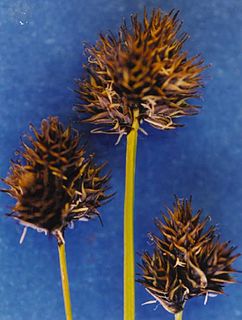
Carex haydeniana is a species of sedge known by the common name cloud sedge.
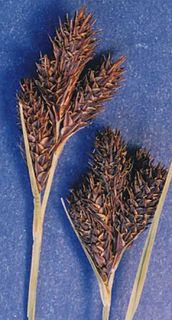
Carex helleri is a species of sedge known by the common name Heller's sedge. It is native to eastern California and western Nevada, where it grows on rocky mountain slopes and in other habitats.
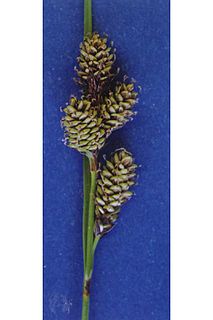
Carex heteroneura is a species of sedge known by the common name different-nerve sedge. It is native to western Canada and the western United States, where it grows in moist mountain habitat such as forests and meadows.

Carex illota is a species of sedge known by the common name sheep sedge. It is native to western North America, where it grows in wet places such as marshes and mountain meadows, from New Mexico and California north to Western Canada.

Carex jonesii is a species of sedge known by the common name Jones' sedge.

Carex luzulina is a species of sedge known by the common name woodrush sedge.

Carex mariposana is a species of sedge known by the common name Mariposa sedge.
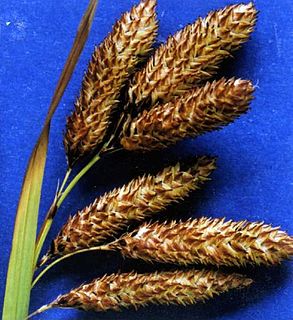
Carex mertensii is a species of sedge known by the common name Mertens' sedge. It is native to western North America from Alaska to California to Montana, where it grows in moist and wet habitat in mountain forests and meadows. This sedge produces clumps of stems reaching maximum heights between 80 and 120 centimeters. The leaves are small; those toward the bases of the stems are reduced to sheaths only. The inflorescence is a densely packed, bullet shaped cluster of overlapping flowers, mainly hanging on long peduncles. Each inflorescence is generally 2 to 4 centimeters long. Each of the flowers has a dark-colored bract.

Carex multicostata is a species of sedge known by the common name manyrib sedge.
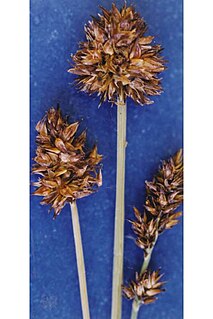
Carex neurophora is a species of sedge known by the common name alpine nerve sedge. It is native to the western United States, where it grows in wet mountain habitat such as meadows and streambanks. This sedge produces stems up to about 60 centimeters tall and inflorescences which are dense, oblong clusters of indistinguishable spikes of flowers.
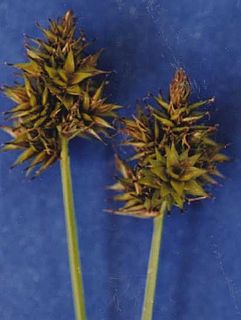
Carex pachystachya is a species of sedge known by the common name Chamisso sedge.
Carex petasata is a species of sedge known by the common name Liddon sedge.

Carex phaeocephala is a species of sedge known by the common name dunhead sedge.
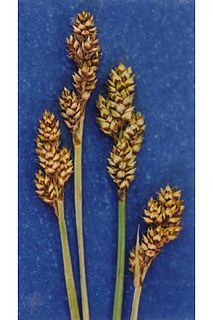
Carex praeceptorum is a species of sedge known by the common names early sedge and teacher's sedge.
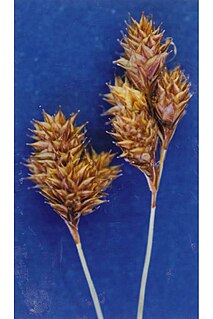
Carex proposita is a species of sedge known by the common name Great Smoky Mountain sedge. It has a scattered distribution in parts of the western United States, including Washington, Idaho, and California. It was named for the Smoky Mountains of Idaho, not the Great Smoky Mountains, where it does not occur. This sedge produces low, dense clumps of stems under 35 centimeters tall. The inflorescence is a dense or open bundle of rounded or oval brown flower spikes. The fruit is coated in a veined perigynium with a white tip.

Carex rossii, commonly known as Ross's sedge, is a hardy species of sedge that is often a pioneer species in areas with little or no established vegetation, or in places where disturbance has occurred. Ross's sedge grows in a variety of habitats throughout much of western North America, from Alaska to Ontario, south to New Mexico and California. It flowers in May and June.
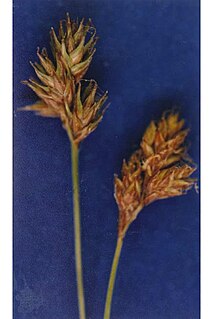
Carex straminiformis is a species of sedge known by the common name Shasta sedge.
This page is based on this
Wikipedia article Text is available under the
CC BY-SA 4.0 license; additional terms may apply.
Images, videos and audio are available under their respective licenses.


















